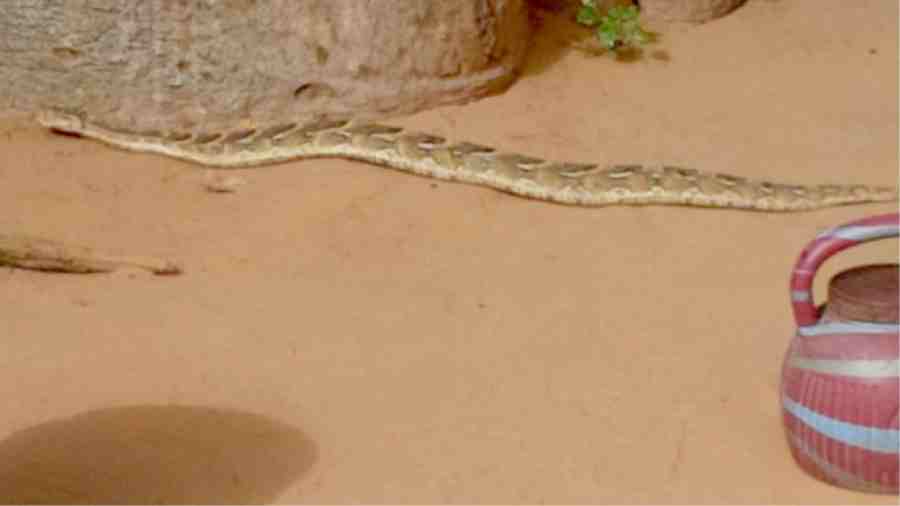The first time I witnessed a patient who had been bitten by a snake was during my days as a young house officer. It was a slow Saturday evening and I was on call at the accident and emergency ward. My prayers seemed to be working that day as the afternoon shift had been mostly calm, so calm in fact that I had the luxury of relaxing on my chair while reading Jeffery Archer’s ‘False Impression’. I remember because I was so engrossed in the book that I did not notice a middle-aged man being wheeled into the A&E by his relatives. They appeared agitated as they spoke above one another trying to relate their dilemma.
Apparently, Mr Paul*, a 54-year-old farmer had been brought in from a village three hours away in Nasarawa state on account of a snakebite he sustained the day before. He had been bitten on his left foot and the limb was now swollen and appeared darker in complexion than the rest of his body. A dirty rag was tied to his left ankle, presumably by the relatives, to stop the spread of the venom. My mouth was dry and my hands were shaking as I examined his foot, which had swollen to almost twice its original size. There was evidence of two puncture marks, which I assumed was the site of the bite near his big toe and other scarification marks on the dorsum of the foot that I was later told was made by a traditional ‘wanzami’ (barber) as a treatment for the bite. When the pain had become unbearable despite their intervention, Paul’s sons had insisted on bringing him to the hospital.
I tried to remain calm but my brain had gone into panic mode trying desperately to remember the steps involved in the management of snakebites. You have to understand, snake bites are not common in Maiduguri and so, I had never encountered any case while in medical school. All I knew about snake bites was strictly theory and even that little knowledge was trying to disgrace me! As I was resuscitating the patient, one of his sons proceeded to tell me how they had hunted down the snake in their farm and killed it upon hearing their father’s scream. As if that was not enough information, the man suddenly dropped the sack he was holding on my table to reveal a dead snake. I nearly passed out from fright! I let out a piercing scream and fled the premises. So much for the doctor on call. Needless to say, I remained the butt of everyone’s joke until I finished my internship.
The second on-call, who is the more senior doctor, was called to salvage the situation. He promptly released the rag, which served as a tourniquet and stabilised the limb. The site of the bite was cleaned and resuscitation continued with Intravenous fluids and painkillers. Later, his blood work would show an abnormal clotting profile even as he started bleeding under his skin and from his gums. In fairness, when the management of the hospital was informed, desperate efforts were made to procure the EchiTAb antivenom but as with all things in Nigeria, bureaucracy and our ‘anyhowness’, made it so that the antivenom arrived four days later when the patient was already haemodynamically unstable. He passed away exactly one week after he was brought to the hospital.
Snakebite envenoming comprises a major public health problem among communities of the savanna region of West Africa, notably in Benin, Burkina-Faso, Cameroon, Ghana, Nigeria and Togo. It ranks high as among the most neglected tropical health problems especially in Nigeria where the incidence is about 497 per 100,000 population per year. In some rural areas along the Benue Valley, snakebite is the leading cause of morbidity and mortality, especially among farmers, pastoralists, hunters and children. The carpet viper (Echis ocellatus) has proved to be the most important cause of snakebite mortality and morbidity in Nigeria and some of its symptoms include local swelling, bleeding and occasionally necrosis. Occasionally, snakebite may lead to important complications such as amputation, blindness resulting from the famous spitting cobra venom, miscarriages, wound infection, tetanus and psychological consequences like anxiety.
Nigeria’s failure to confront snakebite as a public health issue has greatly hampered its control especially in endemic regions of this country. The fact that snakebite is not an infectious disease, nor is it contagious, has contributed significantly to it being alienated from other neglected tropical diseases like leprosy, leishmaniasis and Trypanosomiasis (sleeping sickness). Additionally, Snakebite in Nigeria does not get the attention it deserves because of the fact that it affects mostly the poorest of the poor who live in rural areas. Other factors like the high cost of medical care, poor political will and weak advocacy efforts further fuel the lackadaisical attitude to the burden of snakebite in Nigeria.
Kaltungo town of Gombe State has been famous for cases of snake envenomation since the colonial era, when the snakebite treatment ward was first built in the 1940s. During the late 1980s, during General Babangida’s regime, the Echitab group was established and mandated to oversee the development of more effective anti-venom for the benefit of the country at large, with the state-owned General Hospital Kaltungo, serving as the main host for the research group. In 2006, the Echi-tab Anti-venom that resulted from the work of the research group successfully passed the clinical trial stage and was released to the mainstream market. Unfortunately, despite the memorandum of understanding (MOU) that warranted for the transfer of technology to the country so as to benefit the general population, that never came to fruition due to the failure of the Nigerian Government to fulfil her financial obligations as contained in the MOU.
In January, 2019, the Snakebite Treatment and Research Centre, Kaltungo was commissioned after protracted attempts to achieve that. Since then, the Centre has continued to provide care to about 4,000 cases of snakebite every year, with over 51 per cent of these cases coming from all over the country and even from neighbouring countries like Cameroun and Niger. Despite this wide coverage however, Gombe State Government has remained its sole financier, resulting in gross underfunding.
The cost of a vial of snake antivenom has a risen to a factor of 10 over the past two decades and presently ranges from N8000 to N30,000 per vial depending on the company and where it is being purchased. Despite the 4,000 vials of antivenom donated to Nigeria last year, the demand remains high and a perpetual scarcity exists for the antivenom especially in places like Zamko CHC in Plateau and Kaltungo General Hospital, Gombe where the incidence of snakebite is high and you can get up to 16 to 20 cases per day.
By all ramifications, the burden of snake bite in Nigeria is high and therefore requires multisectoral collaboration with other state governments, the FG, NGOs as well as private organisations to help in funding the Snakebite research centre. All efforts should be made to ensure that people in the endemic regions of the country benefit from the product of the Echi-tab research group and are able to access treatment at an affordable cost. As a preventive measure, protective clothing, including boots and long trousers, should be worn whilst working in snake-infested areas. In addition, communities must be informed and educated about snakebite risks through the use of posters and leaflets. They should be offered realistic solutions that mitigate the hazards and empower the people themselves to help manage the problem in practical and sustainable ways.
Snakebite envenomation is a terrible thing to witness. Since my encounter with Paul* over 10 years ago, I have encountered a few more cases with each one giving me terrible nightmares. I can only imagine what doctors practising in rural communities go through. Or maybe they have become desensitised to the trauma, I don’t know. What I do know, however, is that I will never forgive that man who dropped a dead snake on my desk years ago and made me the laughing stock of the whole hospital.

 Join Daily Trust WhatsApp Community For Quick Access To News and Happenings Around You.
Join Daily Trust WhatsApp Community For Quick Access To News and Happenings Around You.


